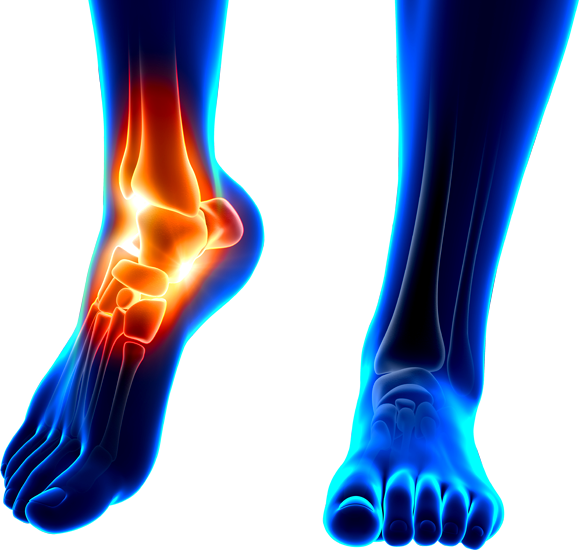Leeds Foot & Ankle Clinic
Experts in foot and ankle surgery

Ankle Arthroscopy.
What is Ankle Arthroscopy?
Ankle arthroscopy is a minimally invasive (key hole) surgical procedure that allows your surgeon to examine and treat problems within your ankle joint using a specialised instrument called an arthroscope. The arthroscope is a thin, flexible tube with a camera attached to the end, which transmits images to a monitor, enabling your surgeon to see inside your ankle joint without making large incisions.
Why is Ankle Arthroscopy Performed?
Ankle arthroscopy is performed for both diagnostic and therapeutic purposes. It helps your doctor diagnose the cause of ankle pain, swelling, or instability by providing a clear view of the structures within the joint. It can also be used to treat various ankle conditions, including
- Ankle Impingement: When extra bone or soft tissue forms within the joint, causing pain and limited range of motion. This can occur after an injury or fracture around the ankle, or can occur due to early arthritis in the ankle joint.
- Ankle Ligament Tears: Injuries to the ligaments that stabilise the ankle joint, such as lateral ankle sprains. Ligament stabilisation surgery (Brostrum reconstruction) can be done using entirely minimally invasive surgery using key hole incisions and ankle arthroscopy.
- Osteochondral Lesions: Damaged or loose pieces of cartilage or bone within the joint
- Synovitis: Inflammation of the synovial lining of the joint. This often is a cause of pain and impingement, commonly after trauma to the ankle such as a sprain or fracture.
- Ankle Fractures: Certain types of ankle fractures may require arthroscopic treatment, usually to deal with cartilage damage that occurs at the time as the fracture.
- Tendon Disorders: Conditions affecting the tendons around the ankle, such as tendinitis or tenosynovitis can sometimes be assessed and treated using the arthroscope.
- Posterior impingement / Os Trigonum: Soft tissue and / or bone prominence around the back of the ankle. This is a common cause of ankle pain, particularly in sports people and dancers.
- Fusion of the Ankle Joint and / or Sub Talar Joint: Performed to fuse the joint to remove and treat pain caused by significant (end-stage) arthritis of the ankle joint or joints around the ankle.
What are the benefits of arthroscopic surgery for the ankle?
- Minimally invasive procedure with smaller incisions, resulting in less scarring and faster recovery.
- Reduced pain and swelling after surgery compared to traditional open surgery.
- Shorter hospital stay or possible outpatient procedure.
- Earlier return to normal activities and sports.
What are the risks and complications of ankle arthroscopy?
Although ankle arthroscopy is considered safe, complications may occur in rare cases and no surgery is without a small degree of risk. Complications include:
- Infection.
- Bleeding.
- Blood clots (DVT/PE).
- Nerve damage that may cause numbness and/or tingling in the foot.
- Joint stiffness or weakness.
- Pain.
The specific risks of your individual procedure will be discussed with you before the surgery.
What will happen during the procedure?
- You will receive anaesthesia (general or occasionally regional) to ensure your comfort throughout the procedure.
- The surgeon will make small (approx. 1cm) incisions around your ankle to insert the arthroscope and other surgical instruments.
- The arthroscope will be guided into your ankle joint, and images will be transmitted to a monitor.
- Your surgeon will examine the joint, identify any problems, and perform necessary treatments, such as removing loose fragments, repairing ligaments, or trimming excess tissue and/or bone.
- After completing the procedure, the incisions will be closed with stitches or adhesive strips, and a dressing or bandage will be applied.
What will happen after the procedure?
- You will be monitored in the recovery area until the anaesthetic wears off.
- You will spend a short time on the ward after the surgery to ensure you are safe for discharge home and usually after having something to eat and drink.
- You may experience some pain and swelling during the first few weeks after the procedure, which can be managed with prescribed pain medications, ice packs, rest and elevation of the leg.
- Follow your surgeon's instructions regarding weight-bearing restrictions, dressing changes, and wound care.
- Follow up arrangements will be made to attend to the wounds and dressings around 2 weeks after the surgery.
- Keep the dressings and wounds dry until the stiches have been removed by the nurses at your first out patient clinic appointment.
- Physiotherapy or rehabilitation exercises may be recommended to aid in your recovery and restore strength and mobility to your ankle.